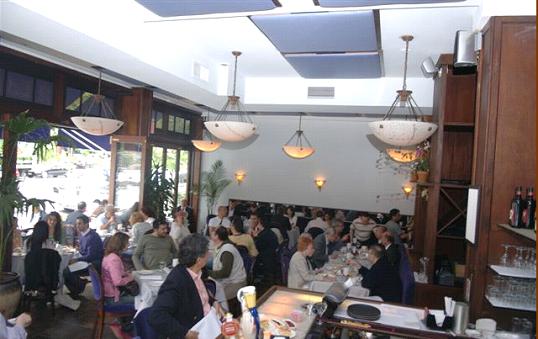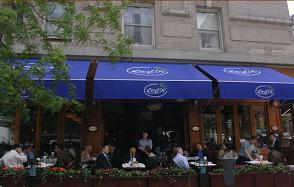Note: Click here for a more recent visit to Eleven Madison Park.
In 1998, Danny Meyer did the absurd. Within a month’s time, he opened two contrasting luxury restaurants in a neighborhood not then known for fine dining. The location, a landmarked Art Deco building, ought to have been perfect, but it adjoined the dilapidated Madison Park, better known at the time for drug dealers, broken fences, and crumbling asphalt. The park was eventually rebuilt (Meyer himself contributed $60,000), and both restaurants were hits.
 Apparently, Meyer’s original intention was to open just one restaurant on the ground floor of the old Met Life building, but the wall separating two dining rooms had landmark status, and couldn’t be removed. So in the smaller of the two spaces, he opened the Indian-fusion restaurant Tabla; and in the spectacular former Assembly Hall, he opened Eleven Madison Park.
Apparently, Meyer’s original intention was to open just one restaurant on the ground floor of the old Met Life building, but the wall separating two dining rooms had landmark status, and couldn’t be removed. So in the smaller of the two spaces, he opened the Indian-fusion restaurant Tabla; and in the spectacular former Assembly Hall, he opened Eleven Madison Park.
Though both restaurants were a success, Ruth Reichl in the Times found Tabla more impressive, awarding three stars. To Eleven Madison Park, she awarded only two in a 1999 review, finding chef Kerry Heffernan’s main courses “disappointingly uneven.” Six years later, for no apparent reason, Frank Bruni re-reviewed Eleven Madison Park, again awarding two stars, finding “much of his food…unremarkable” and “some of it…poorly executed.”
My only visit to Eleven Madison Park under Chef Heffernan was on Mother’s Day in 2005. I was impressed with a five-course tasting menu, especially bearing in mind that most restaurants under-perform on major holidays. But most observers didn’t share my three-star assessment. By the end of the year, Chef Heffernan had departed, replaced by wunderkind Daniel Humm. Suddenly, the food community was buzzing that Eleven Madison Park was practically a new restaurant.

The Gourmand Tasting MenuFrank Bruni took notice, issuing using the first self-re-review of his tenure to elevate Eleven Madison Park to three stars. (He then managed the peculiar feat of insulting the restaurant by absurdly awarding another three stars to the casual Bar Room at The Modern in the same review—in the process dissing the best restaurant in Danny Meyer’s empire, the main dining room at The Modern.)
Last week, my girlfriend and I returned to Eleven Madison Park, our first visit since Chef Humm took over. Nowadays, the restaurant offers a three-course prix fixe at $82, a four-course prix fixe at $96, or a Gourmand tasting menu, which we ordered, at $155. Counting hors d’oeuvres and petits-fours, that tasting menu weighs in at 13 courses, making it one of the city’s more ambitious of its kind.
A full description of 13 courses would extend this post to the length of a minor novel, so an impressionistic fly-by will have to suffice. The full menu is pictured above right (click for a larger image).


Hors d’oeuvres (left); Maine Diver Scallop with caviar (right)
The hors d’oeuvres were mind-blowingly good. From left to right, I believe they were a foie gras sandwich; a sweetbread; hamachi in a cucumber wrap; and sorry, I cannot recall the fourth.
I loved the first savory course, a diver scallop with caviar. My girlfriend doesn’t eat scallops, so they just gave her a version of the dish with the scallop omitted, which we thought was a rather unimaginative substitute.


California Celery, Cappuccino with Celery Root, and Black Truffles (left); Peekytoe Crab Cannelloni (right)
A celery and cappuccino puree with black truffles was topped with a fried quail egg. Peekytoe Crab Cannelloni was satisfactory, though it did not eclipse our memory of the crab salad we had at Daniel a couple of months ago.


Foie gras with Venezuelan Cocoa and Quince (left); Mediterranean Loup de Mer (right)
It’s hard to go wrong with foie gras, but the torchon here was particularly dreamy. The accompanying soft brioche was wonderful—but also, in a way, superfluous. Chef Humm has a delicate touch with fish, and the Loup de Mer was wonderful.


Scottish Langoustine (left); Four Story Hill “Boudin Blanc” (right)
The next couple of courses didn’t register as impressively. A Scottish Langoustine was slightly dull, as was the boudin (a kind of sausage), though I was a bit more fond of it than my girlfriend was.

Three variations of Vermont Farm Suckling PigSuckling pig is apparently Chef Humm’s signature dish. Frank Bruni raved about it. When he came out to greet diners late in our meal, he made sure to ask, “How about the pig?”
My girlfriend was transported, though I found it a bit too dry. We overheard diners at the next table, and their views were exactly reversed: it was the lady who thought hers was too dry. I’d love to come back and try the full entrée version of it.
My sense was that this is precisely the kind of dish that suffers from being served in a tasting menu portion. You need more of it, to give the fat room to spread out, to give alternating crisp and gooey textures the chance to shine.


Lynnhaven “Chèvre Frais” (left); Coconut sorbet with pear and parsnips (right)
The next two courses are perhaps best classified as palate-cleansers. Nothing stands out about them, and I present them (above) without comment.


Chocolate cake with Passion Fruit Bourbon Sour (left); Candied lollipops (right)
The main dessert course was a wonderful chocolate cake with a passion fruit bourbon sour for contrast. I only wish I had had enough appetite left to enjoy more of the candied lollipops.
Service throughout the evening was up the the standard you come to expect at a Danny Meyer restaurant. Given his success, I wonder why more restauranteurs don’t emulate him? When I arrived, the host offered immediately to show me to the table—rather than insisting I wait at the bar until my date arrived, as so many restaurants do these days.
The wine list is excellent, with a good selection of half-bottles. I was also pleased to see a decent selection below $60, an price level often not available at restaurants in this class. Our wine selection was unimaginative: a Barolo that I chose for no other reason than I was happy to find it at $89. The staff decanted it, a service few restaurants offer these days. Wine decanters are an Eleven Madison Park specialty, and you see them on display in a wide variety of shapes.
The bread service, too, was excellent, with nice soft butter in a silver serving dish, and several home-made breads to spread it on. The whole meal took around 3½ hour, and I was never conscious of it being either too fast or too slow.
The large space, with its soaring Art Deco ceilings, leave some people cold. We find it coolly elegant and understated, but it won’t be to all tastes. We were happy to find that those high ceilings gave ample room for the sound level to dissipate, but the restaurant wasn’t quite full, so we didn’t have the acid test. We were seated at a table that could normally accomodate four, so we had a bit more space to ourselves than we normally would.
A few of the courses on our Gourmand tasting menu misfired slightly, but I say this only in relation to the high expectations one has at a price level that puts Eleven Madison Park near the top of the heap in this already expensive city. Overall, it was a wonderful experience. I would be delighted to return.
Eleven Madison Park (11 Madison Avenue at 24th Street, Flatiron District)
Food: ***½
Service: ***½
Ambiance: ***
Overall: ***½
 Tuesday, April 10, 2007 at 01:12PM
Tuesday, April 10, 2007 at 01:12PM 














 Pacific Coast Highway in
Pacific Coast Highway in  Travel
Travel 







































 Lower East Side newcomer
Lower East Side newcomer 









